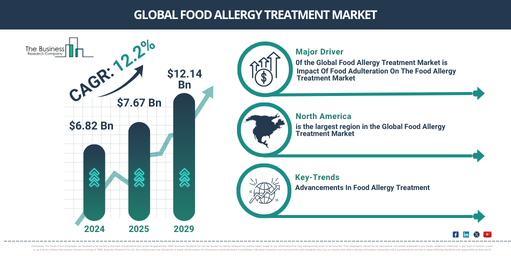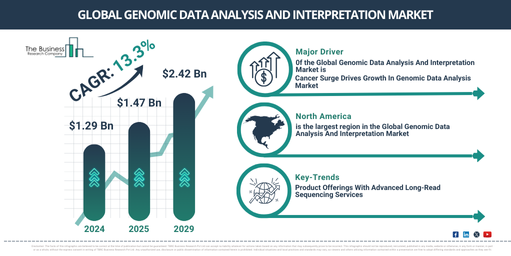$12.14 Billion Forecast for Food Allergy Treatment Market by 2029, Backed by Demand and Innovation
Discover trends, market shifts, and competitive outlooks for the food allergy treatment industry through 2025-2034 with The Business Research Company’s reliable data and in-depth research
What is the Anticipated CAGR of the Food Allergy Treatment Market, and What Factors Will Drive It?
There has been a swift expansion in the market size for food allergy treatment in the past years. The market is projected to rise from $6.82 billion in 2024 to $7.67 billion in 2025, showcasing a compound annual growth rate (CAGR) of 12.5%. Factors that are attributed to the growth during the historic period comprise of heightened occurrence of food allergies, increased regulatory approvals, progress in emergency treatments, and significant investment in cutting-edge technologies.
Over the next few years, the market for food allergy treatments is predicted to expand rapidly, reaching a size of $12.14 billion in 2029 with a compound annual growth rate (CAGR) of 12.2%. This significant growth, anticipated over the forecast period, is due to several factors such as an increase in the elderly population, a rise in food allergy diagnoses, escalation in healthcare expenditure, a surge in reported cases of asthma, and a widespread prevalence of food allergies. Key trends during this forecast period are anticipated to include a remarkable level of innovation and technological progress, enhancements in medical technology and diagnostic methodologies, a rise in the usage of mobile applications and telemedicine services, an escalation in the number of research and development initiatives, and a steep increase in drug approvals and product launches.
Download a free sample to assess the report’s scope and structure:
https://www.thebusinessresearchcompany.com/sample.aspx?id=16684&type=smp
What are the Fundamental Drivers and Innovations Shaping the Food Allergy Treatment Market?
The rise in food adulteration is predicted to stimulate the expansion of the food allergy treatment market. The term “food adulteration” relates to the deliberate modification of foodstuffs by adding substandard, hazardous, or unauthorized substances, or by eliminating crucial ingredients, in order to increase volume or augment appearance, frequently compromising both quality and safety. Several factors such as economic benefits, intricate supply chains, regulatory insufficiency, technological developments, the appeal for ready-made products, globalization, environmental aspects, consumer consciousness, profit objectives, and slack law enforcement are making food adulteration more prevalent. The increasing preference for less expensive products is primarily fueling food adulteration as it encourages manufacturers to manage expenses and enhance profits through unprincipled methods. Food adulteration can intensify the threat of allergies by incorporating allergens into foodstuffs or by undermining the safety and soundness of the food supply. For example, the Netherlands-based government organization, Europol, stated in November 2022 that during Operation OPSON XI, managed by Europol, authorities from 26 countries confiscated nearly 27,000 tons of forged food and 15 million liters of alcoholic drinks between December 2021 and May 2022. Consequently, the ascending prevalence of food adulteration is boosting the growth of the food allergy treatment market.
What Segment Types Define the Food Allergy Treatment Market Structure?
The food allergy treatment market covered in this report is segmented –
1) By Drug Type: Antihistamines, Decongestants, Corticosteroids, Mast Cell Stabilizers, Leukotriene Inhibitors, Nasal Anti-Cholinergic, Immuno-Modulators, Epinephrine, Immunotherapy
2) By Route Of Administration: Parenteral, Oral
3) By Allergen Type: Dairy Products, Poultry Product, Tree Nuts, Peanuts, Shellfish, Wheat, Soys, Other Allergens
4) By End-Use: Hospital Pharmacies, Retail Pharmacies, Other End-Uses
Subsegments:
1) By Antihistamines: Oral Antihistamines, Topical Antihistamines, Intranasal Antihistamines
2) By Decongestants: Oral Decongestants, Nasal Decongestants
3) By Corticosteroids: Oral Corticosteroids, Topical Corticosteroids, Intranasal Corticosteroids
4) By Mast Cell Stabilizers: Cromolyn Sodium, Nedocromil
5) By Leukotriene Inhibitors: Montelukast, Zafirlukast
6) By Nasal Anti-Cholinergic: Ipratropium Bromide
7) By Immuno-Modulators: Omalizumab, Dupilumab
8) By Epinephrine: Injectable Epinephrine, Auto-Injectors
9) By Immunotherapy: Oral Immunotherapy (OIT), Sublingual Immunotherapy (SLIT), Epicutaneous Immunotherapy (EPIT)
Request customized data on this market:
https://www.thebusinessresearchcompany.com/customise?id=16684&type=smp
Which Regions Are Driving the Next Phase of the Food Allergy Treatment Market Growth?
North America was the largest region in the food allergy treatment market in 2024. Asia-Pacific is expected to be the fastest-growing region in the forecast period. The regions covered in the food allergy treatment market report are Asia-Pacific, Western Europe, Eastern Europe, North America, South America, Middle East, Africa.
Which Cutting-Edge Market Trends Are Expected to Drive the Food Allergy Treatment Market’s Growth?
Leading firms in the food allergy treatment sector are spearheading the creation of cutting-edge therapies like monoclonal antibodies, to delve into the root causes of food allergies and provide patients with more effective treatments. This innovation highlights a hopeful strategy in handling food allergies by focusing on specific elements of the immune system linked with allergic responses, thus offering more efficient and targeted treatment options. For instance, Novartis AG, a pharmaceutical enterprise headquartered in Switzerland, was given the green light by the FDA in February 2024 for its Xolair (omalizumab), a treatment meant to lessen IgE-mediated food allergies. Xolair, a humanized monoclonal antibody that’s given subcutaneously, functions by obstructing the binding of IgE antibodies, resulting in a decreased release of substances that cause allergy symptoms. The FDA’s endorsement came following optimistic results from the Phase III OUtMATCH trial, which revealed that a significantly higher number of food allergy patients, some as young as 1 year, who were treated with Xolair were able to tolerate minor amounts of peanuts, milk, eggs, and cashews without triggering an allergic reaction compared to those on placebo.
View the full report here:
https://www.thebusinessresearchcompany.com/report/food-allergy-treatment-global-market-report
What Is the Definition of the Food Allergy Treatment Market?
Food allergy treatment refers to the medical interventions and strategies employed to prevent, manage, and treat allergic reactions triggered by specific foods. The goal of food allergy treatment is to reduce the frequency and severity of allergic reactions, improve the quality of life for affected individuals, and enhance overall patient safety.
Purchase the full report and get a swift delivery:
https://www.thebusinessresearchcompany.com/purchaseoptions.aspx?id=16684
About The Business Research Company:
With over 15000+ reports from 27 industries covering 60+ geographies, The Business Research Company has built a reputation for offering comprehensive, data-rich research and insights. Armed with 1,500,000 datasets, the optimistic contribution of in-depth secondary research, and unique insights from industry leaders, you can get the information you need to stay ahead in the game.
Get in touch with us:
The Business Research Company: https://www.thebusinessresearchcompany.com/
Americas +1 3156230293
Asia +44 2071930708
Europe +44 2071930708
Email us at info@tbrc.info
Follow us on:
LinkedIn: https://in.linkedin.com/company/the-business-research-company
YouTube: https://www.youtube.com/channel/UC24_fI0rV8cR5DxlCpgmyFQ
Global Market Model: https://www.thebusinessresearchcompany.com/global-market-model



